Topic: Birds: insights into convergence
Intriguing ecological and morphological parallels can be found among the Neoaves. Many of these forms were initially believed to be each other's closest relatives, but are now widely recognised as classic examples of convergence. Think how similar swifts and swallows are, but they are only distantly related.
Relationships within birds
The inter-relationships within the birds have been very controversial for many years, but continuing advances in molecular biology are slowly beginning to provide a clearer picture. In outline, the living birds are referred to as the Neornithes. They are divided into two groups: the Palaeognathae include the large flightless ratites and the related tinamous (Tinamidae), while all other birds are placed in the Neognathae. The Neognathae are further split into waterfowl plus fowl and the so-called Neoaves. It is this last group that is the focus of attention for this entry. A recent molecular study has supported two evolutionary assemblages in the Neoaves: the Metaves and the Coronaves (Fain and Houde 2004, Evolution, vol. 58, pp. 2558-2573).
Fain and Houde furthermore suggest that these two sister clades have undergone diverse parallel radiations that indicate broad patterns of convergent morphological evolution and show an intriguing resemblance with the classic marsupial-placental convergences. They consider the proposed Metaves, which are very diverse in morphology but not particularly rich in taxa, as analogous to marsupials, whilst the speciose Coronaves resemble the placental mammals. The marsupial-placental split, however, is corroborated by numerous physiological and anatomical synapomorphies and there is also a geographic division between the two lineages. The Metaves, on the other hand, are neither united by a single derived morphological character nor clearly geographically separated from the Coronaves, rendering this analogy a rather problematic one.
There are also more general issues with Fain and Houde’s phylogenetic hypothesis, which is not widely accepted. This is because their analysis was solely based on the sequence of intron 7 of the β-fibrinogen gene and has been criticised for fixation on a single nuclear locus. Since its publication, no other dataset has found support for the proposed division of the Neoaves, neither a cladistic analysis of morphological characters nor analyses of other genes. Morgan-Richards and colleagues (2008, BMC Evolutionary Biology, vol. 8(1), art. no. 20) could not confirm the Metaves clade based on complete mitochondrial genomes of seven presumably metavian bird species. They suggested that the high number of indels (insertions and/or deletions) within intron 7 could have caused artefacts during analysis.
Examples of convergence in the Neoaves
Nevertheless, it is important to stress that, independent of the ongoing taxonomic debate, various ecological and morphological parallels can be found among the Neoaves. Many of these forms were initially believed to be closely related, but are now widely recognised as classic examples of convergence. Whether they represent specific convergences between coronavian and metavian birds, as proposed by Fain and Houde, remains to be seen.
Turacos and hoatzin
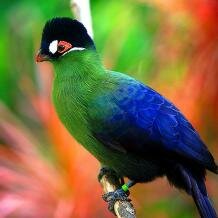
 Turacos (Musophagidae) and the hoatzin (Opisthocomus hoazin) are large birds with prominent feathered head crests that eat leaves and fruit. Aided by zygodactyl feet (two toes facing forward, two backward), they are adept arboreal dwellers and, remarkably, the nestlings use wing claws for climbing. The adults are poor fliers. While the hoatzin is endemic to South America, turacos live in sub-Saharan Africa. The specific convergences refer to the forest-dwelling species, but the group is quite diverse and some species live in open habitats. Unsurprisingly, prior to the molecular data the great majority of ornithologists were struck by the many morphological similarities between the hoatzin and turacos and accordingly placed them in close phylogenetic proximity. The precise phylogenetic position of the hoatzin has proved remarkably difficult to define and disagreement continues in this area. Most likely, perhaps, is a rather distant connection to the doves.
Turacos (Musophagidae) and the hoatzin (Opisthocomus hoazin) are large birds with prominent feathered head crests that eat leaves and fruit. Aided by zygodactyl feet (two toes facing forward, two backward), they are adept arboreal dwellers and, remarkably, the nestlings use wing claws for climbing. The adults are poor fliers. While the hoatzin is endemic to South America, turacos live in sub-Saharan Africa. The specific convergences refer to the forest-dwelling species, but the group is quite diverse and some species live in open habitats. Unsurprisingly, prior to the molecular data the great majority of ornithologists were struck by the many morphological similarities between the hoatzin and turacos and accordingly placed them in close phylogenetic proximity. The precise phylogenetic position of the hoatzin has proved remarkably difficult to define and disagreement continues in this area. Most likely, perhaps, is a rather distant connection to the doves.
Bitterns and sunbittern

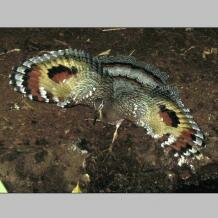 The widely distributed bitterns (Botaurinae) and the tropical American sunbittern (Eurypyga helias) are strikingly similar in overall shape and their way of life. Both not only stalk prey stealthily with great care, typically in an aquatic setting, but are also adept at melting into the background, aided by their subdued colouration. Sunbitterns are so-called because of a spectacular display, during which the brownish bird opens its wings and exposes brightly coloured patches in order to attract mates, threaten rivals or deter predators.
The widely distributed bitterns (Botaurinae) and the tropical American sunbittern (Eurypyga helias) are strikingly similar in overall shape and their way of life. Both not only stalk prey stealthily with great care, typically in an aquatic setting, but are also adept at melting into the background, aided by their subdued colouration. Sunbitterns are so-called because of a spectacular display, during which the brownish bird opens its wings and exposes brightly coloured patches in order to attract mates, threaten rivals or deter predators.
Spoonbills and flamingos

 Spoonbills (Plateinae) and flamingos (Phoenicopteridae) are both long-legged wading birds that filter-feed by sweeping their head from side-to-side and breed in colonies. The roseate spoonbill (Platalea ajaja), as its name suggests, even possesses the famous pink colouration of the flamingos that is due to carotenoid pigments in their diet. The specifics of the flamingo feeding, with their characteristic beaks filtering out food particles aided by hairy lamellae and the large tongue, show striking parallels to a number of other birds, filter-feeding baleen whales and even extinct pterosaurs.
Spoonbills (Plateinae) and flamingos (Phoenicopteridae) are both long-legged wading birds that filter-feed by sweeping their head from side-to-side and breed in colonies. The roseate spoonbill (Platalea ajaja), as its name suggests, even possesses the famous pink colouration of the flamingos that is due to carotenoid pigments in their diet. The specifics of the flamingo feeding, with their characteristic beaks filtering out food particles aided by hairy lamellae and the large tongue, show striking parallels to a number of other birds, filter-feeding baleen whales and even extinct pterosaurs.
Boobies and tropicbirds
Both boobies (genus Sula) and tropicbirds (Phaethontidae) are highly successful pelagic seabirds, hunting the same patchy resources of nekton, notably squid and flying fish (which actually glide rather than fly). They hunt by plunge-diving and to protect themselves from the impact they have independently evolved a network of air sacs beneath the skin to cushion the blow.
Owls and frogmouths

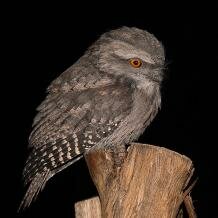 As nocturnal predators, owls (Strigiformes) and frogmouths (Podargidae) share a similar morphology characterised by a large round head with huge, forward-facing eyes on a rather sturdy body. The Australian tawny frogmouth (Podargus strigoides), for example, is often mistaken for an owl and referred to as “mopoke” or “morepork”, which are in fact common names for the Southern boobook owl (Ninox novaeseelandiae). Owls and frogmouths are both reclusive and secretive when at rest, being well camouflaged by their cryptic plumage, but differ with respect to their hunting strategies and prey spectrum. While owls sweep on their prey with a silent flight, frogmouths are rather poor flyers that wait for prey on a perch. Owls hunt generally larger, mainly mammalian prey and grip it with their powerful feet that are equipped with sharp talons. Most frogmouths feed on insects, which they capture with their huge frog-like gape (after which they are named). The disparity in species numbers between the two groups is particularly large. While there are only 13 species of frogmouth, which are limited to India, South Asia and Australia, the widely distributed owls include about 200 species.
As nocturnal predators, owls (Strigiformes) and frogmouths (Podargidae) share a similar morphology characterised by a large round head with huge, forward-facing eyes on a rather sturdy body. The Australian tawny frogmouth (Podargus strigoides), for example, is often mistaken for an owl and referred to as “mopoke” or “morepork”, which are in fact common names for the Southern boobook owl (Ninox novaeseelandiae). Owls and frogmouths are both reclusive and secretive when at rest, being well camouflaged by their cryptic plumage, but differ with respect to their hunting strategies and prey spectrum. While owls sweep on their prey with a silent flight, frogmouths are rather poor flyers that wait for prey on a perch. Owls hunt generally larger, mainly mammalian prey and grip it with their powerful feet that are equipped with sharp talons. Most frogmouths feed on insects, which they capture with their huge frog-like gape (after which they are named). The disparity in species numbers between the two groups is particularly large. While there are only 13 species of frogmouth, which are limited to India, South Asia and Australia, the widely distributed owls include about 200 species.
Sunbirds and hummingbirds
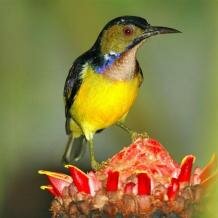
 The Old World sunbirds (Nectariniidae) and the American hummingbirds (Trochilidae) are both nectivores with striking iridescent plumage. In adaptation to their nectar-feeding lifestyle, these small and light birds have long beaks and extensible, grooved or trough-like tongues tipped with brush-like filaments. While both sunbirds and hummingbirds are fast, adept flyers, the latter are especially famous for their ability to hover in front of a flower with incredible precision. Some sunbirds can also take nectar by hovering, but they more often feed from a perched position. Since nectar is low in protein, both augment their diet by sporadically eating small arthropods, such as insects and spiders (especially when feeding young). To conserve energy, they have evolved the ability to enter daily torpor, a hibernation-like state of decreased physiological activity. Hummingbirds furthermore show striking convergence in form and mode of life with ‘hummingbirdoid’ moths (hawk or sphinx moths).
The Old World sunbirds (Nectariniidae) and the American hummingbirds (Trochilidae) are both nectivores with striking iridescent plumage. In adaptation to their nectar-feeding lifestyle, these small and light birds have long beaks and extensible, grooved or trough-like tongues tipped with brush-like filaments. While both sunbirds and hummingbirds are fast, adept flyers, the latter are especially famous for their ability to hover in front of a flower with incredible precision. Some sunbirds can also take nectar by hovering, but they more often feed from a perched position. Since nectar is low in protein, both augment their diet by sporadically eating small arthropods, such as insects and spiders (especially when feeding young). To conserve energy, they have evolved the ability to enter daily torpor, a hibernation-like state of decreased physiological activity. Hummingbirds furthermore show striking convergence in form and mode of life with ‘hummingbirdoid’ moths (hawk or sphinx moths).
Swallows and swifts
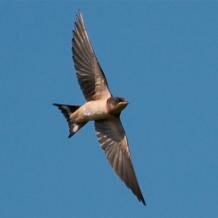
 Swallows (Hirundinidae) and swifts (Apodidae), striking and admired, are fast aerial insectivores. Their morphology is strongly convergent with dark, streamlined bodies and long, pointed wings as well as short beaks with a wide gape to catch insects in flight. So much have they adapted to an aerial life that they rarely come down to the ground voluntarily – their short feet are suitable for perching rather than walking. The swifts, which are actually quite closely related to the hummingbirds, are the real masters of the air, not least due to their ability to mate in flight, and are among the fastest animal flyers. Swallows and swifts show a worldwide distribution and those species breeding in temperate regions migrate to the tropics during winter.
Swallows (Hirundinidae) and swifts (Apodidae), striking and admired, are fast aerial insectivores. Their morphology is strongly convergent with dark, streamlined bodies and long, pointed wings as well as short beaks with a wide gape to catch insects in flight. So much have they adapted to an aerial life that they rarely come down to the ground voluntarily – their short feet are suitable for perching rather than walking. The swifts, which are actually quite closely related to the hummingbirds, are the real masters of the air, not least due to their ability to mate in flight, and are among the fastest animal flyers. Swallows and swifts show a worldwide distribution and those species breeding in temperate regions migrate to the tropics during winter.
Loons and grebes
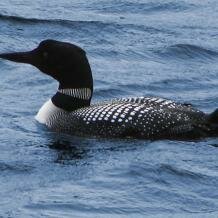
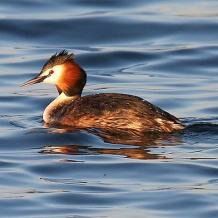 Grebes (Podicipedidae) are closely related to flamingos but strikingly convergent on the equivalent water birds, the loons (Gaviidae). Both are countershaded foot-propelled divers that hunt for aquatic prey, such as fish, crustaceans and freshwater insects. Their feet, which are webbed in loons but possess broad toe lobes in grebes, are placed far back on the body, which makes them excellent swimmers but only poorly adapted to moving on land. It seems that the toe lobes of grebes generate lift comparable to the hydrofoil-shaped blades of a propeller, a mechanism, which might have evolved independently in the Hesperornithiformes, an extinct group of toothed birds from the Cretaceous. Both grebes and loons show high wing loading and are not the most skilful flyers.
Grebes (Podicipedidae) are closely related to flamingos but strikingly convergent on the equivalent water birds, the loons (Gaviidae). Both are countershaded foot-propelled divers that hunt for aquatic prey, such as fish, crustaceans and freshwater insects. Their feet, which are webbed in loons but possess broad toe lobes in grebes, are placed far back on the body, which makes them excellent swimmers but only poorly adapted to moving on land. It seems that the toe lobes of grebes generate lift comparable to the hydrofoil-shaped blades of a propeller, a mechanism, which might have evolved independently in the Hesperornithiformes, an extinct group of toothed birds from the Cretaceous. Both grebes and loons show high wing loading and are not the most skilful flyers.
Hammerkop and kagu
The hammerkop (Scopus umbretta) and the New Caledonian kagu (Rhynochetos jubatus) are not particularly similar in morphology, but show convergence in their ritualised dance display. In the hammerkop, several birds run around each other in circles, while fanning out their head crests, fluttering their wings and calling. Displaying male and female kagus also raise their head crests and present their patterned primary wing feathers, before they circle each other in a courtship dance. The kagu strutting display is not only used in mating but also in territory defence.
Seedsnipes and sandgrouse

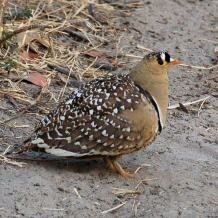 The sandgrouse (Pteroclididae) and seedsnipes (Thinocoridae) are small gregarious granivores that share a very similar morphology. Both have a sturdy body, a small head with a short beak, long wings, short legs and a cryptically coloured plumage. Contrary to what their name suggests, seedsnipes do not exclusively feed on seeds, but take other plant material as well, whereas sandgrouse are actually highly specialised on seeds. While seedsnipes are restricted to harsh environments in the South American Andean and Patagonian regions, sandgrouse inhabit open habitats in the Old World.
The sandgrouse (Pteroclididae) and seedsnipes (Thinocoridae) are small gregarious granivores that share a very similar morphology. Both have a sturdy body, a small head with a short beak, long wings, short legs and a cryptically coloured plumage. Contrary to what their name suggests, seedsnipes do not exclusively feed on seeds, but take other plant material as well, whereas sandgrouse are actually highly specialised on seeds. While seedsnipes are restricted to harsh environments in the South American Andean and Patagonian regions, sandgrouse inhabit open habitats in the Old World.
Cite this web page
Map of Life - "Birds: insights into convergence"
https://mapoflife.org/topics/topic_213_birds-insights-into-convergence/
December 3, 2020

